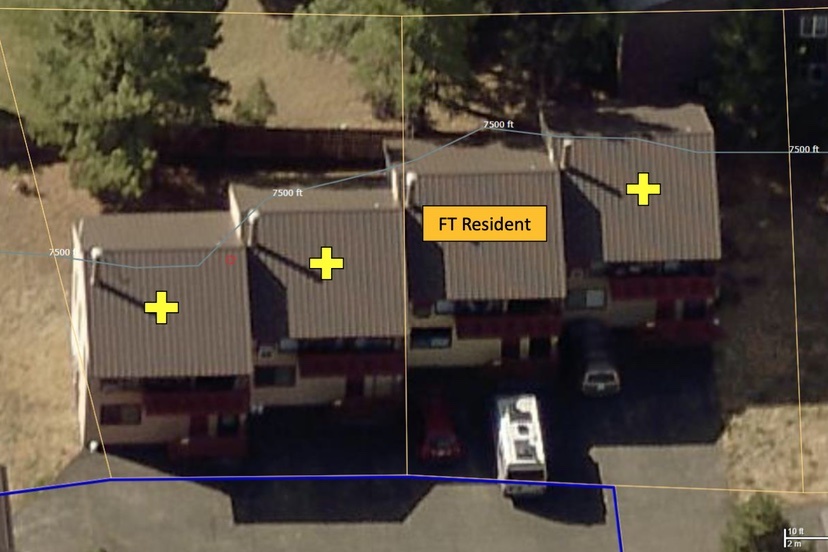Yesterday in Part Three, we were discussing this particular slide…
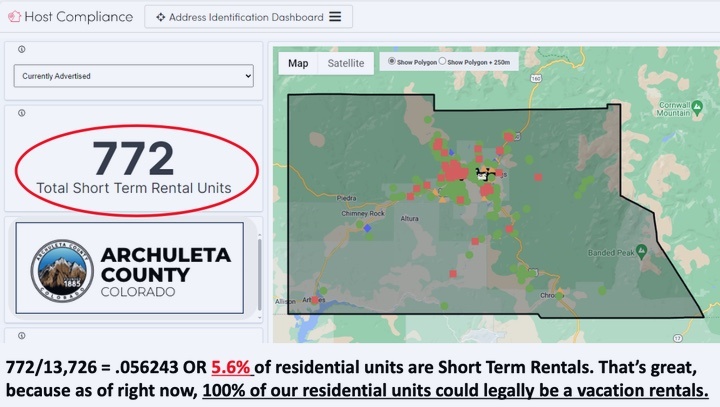
… from the February 22 presentation by Archuleta County Planner Justin Griffin, to the Archuleta County Planning Commission. The basic questions to be addressed were:
Would a cap on the total number of Short-Term Rentals (STRs) — as we find in many Colorado communities — help the struggling Archuleta County economy, and especially the local workforce?
Would density caps — required physical distances between STR units — help prevent our neighborhoods from becoming commercial motel districts?
I was observing from the audience (there were two of us in the audience, and a couple of people listening on Zoom). Listening to the presentation were Planning Commissioners Matt Nobles, Richard Vihel, David Pribble, Mont McAlister, Peter Beaudry, and Jemal Mihalik.
After I published Part Three, I got a call from Mr. Griffin, to clarify his statement that the fact that only 5.6% of the residential dwellings within the unincorporated county have been converted into STRs is “great”. He noted that the general impression on the Planning Commission was that the percentage was much higher than 5.6%, perhaps as high as 20%… in which case, a 5.6% conversion rate could be seen as a positive piece of news.
The incorporated Town, for comparison, has capped the number of STRs in residential neighborhoods at 10%. All of those neighborhoods are already above the limit.
Perhaps Archuleta County doesn’t need to worry about our entire housing stock being converted to STRs? Perhaps no ‘caps’ are needed… even though caps are common in many, if not most, Colorado mountain communities.
Not all the data, however, can be seen as positive.
Mr. Griffin’s presentation shifted gears away from ‘caps’ and focused on ‘density’. Even if our overall total number of STRs is reasonable, are there certain Archuleta County neighborhoods that have become, essentially, commercial motel districts? That is, in fact, the situation in certain neighborhoods.
Mr. Griffin shared some examples of full-time residents who are completely surrounded by (typically unsupervised) mini-motels. The ‘crosses’ indicated STRs.
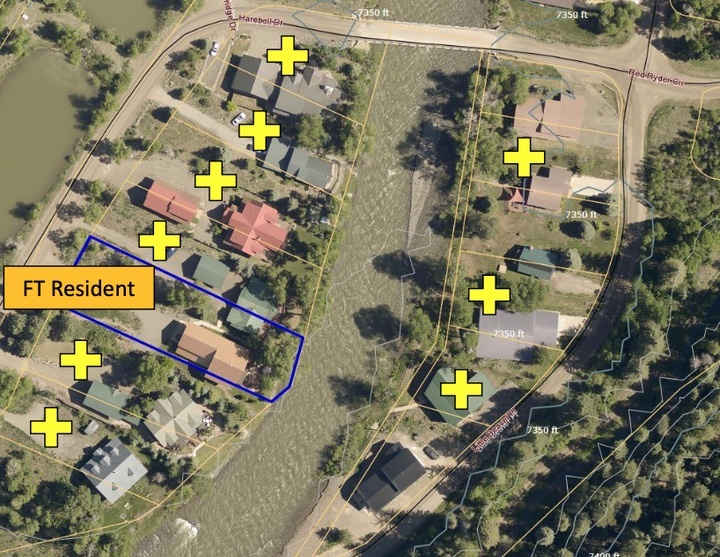
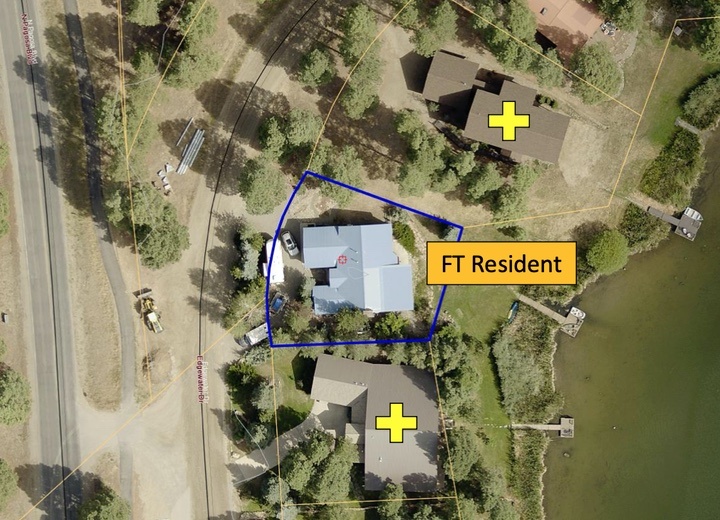
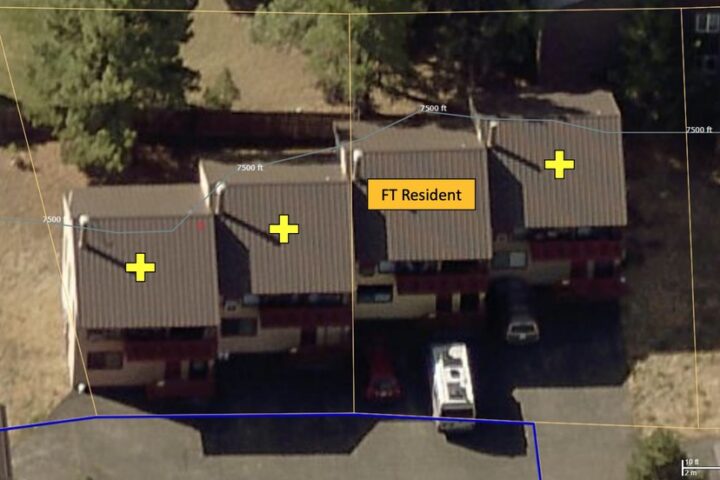
This is not the situation everywhere in the county, of course.
This next image shows a satellite image of 42 Pagosa Lakes homes, four of which are STRs.
So then, about 10% are commercial operations.

When I moved to Pagosa Springs in 1993, our County government did not have zoning districts. I believe the zoning was created around 1999… and as I recall, the process for establishing the zoning designations went something like this:
“Is this neighborhood mostly commercial? Then let’s zone it commercial. And is this other neighborhood mostly residential? Then let’s zone it residential.”
By zoning a neighborhood ‘residential’, the obvious intention — back then — was to simplify and encourage the approval of new residential development, and make it difficult to insert commercial development into the neighborhood.
The STR industry was able to insert commercial businesses into ‘residential zones’ by claiming that an STR is a ‘residential use’.
But we all know it’s a commercial use. We just haven’t managed to get a Colorado judge, or the Colorado Legislature, to confirm that fact.
We know an STR is a commercial use because STRs are required, here in Archuleta County, to obtain a permit in order to do business. Long-term rentals and owner occupied homes do not need a permit, because they are, in fact, residential uses.
Mr. Griffin concluded his presentation with the following policy suggestions:
How do we potentially address these issues?
No non-vacation-rental residential unit shall have more than 1 vacation rental adjacent to any of its property boundaries.
A vacation rental cap rate of 10% per major subdivision or multi unit complex only. Cap rate does NOT apply to minor subdivisions, rural parcels, etc.
NEITHER OF THESE WOULD APPLY TO CURRENT PERMITS. Active permits would be grandfathered. This would be a slow process, as vacation rental permits are not renewed OR as property changes ownership.
I would suggest the following clarifications, which I think are implied in these recommendations. Only one and no more than one STR can be located next door to, directly behind, or directly across the street from a non-STR residential unit (owner occupied, long-term-rental unit, or second-home). A ‘major subdivision’ — a subdivision including four or more parcels — would see the number of STRs capped at 10%, and the same would apply to condos and apartments, but caps would not apply to rural parcels. Existing STR would not be affected by the new regulations so long as they kept their permit active and the property remained with the original applicant.
These are interesting recommendations — to my mind — because they are very similar to the recommendations presented to the Archuleta Board of County Commissioners by an ad hoc citizens’ study group in February 2023.
A couple to differences, however. The ad hoc group recommended a 15% cap for condominiums, and no caps at all for STRs that are owner-occupied. While investor-owned STRs are typically unsupervised, a resident owner offering rooms in their home belongs in a different class, because they are personally supervising their guests, and because they are, in fact, full-time residents who contribute to the community.
The ad hoc group recommended that STRs not be allowed in apartment buildings, because apartments provide crucial long-term housing for local working households.
You can download the citizen study group document here.
The next steps in this process will be — presumably — a recommendation by the County Planning Commission, and then adoption by the BOCC.
Historically, not all recommendations from the Planning Commission get adopted by the BOCC.

